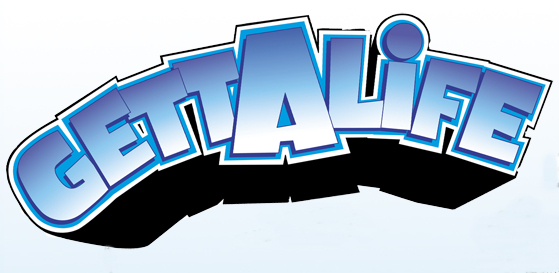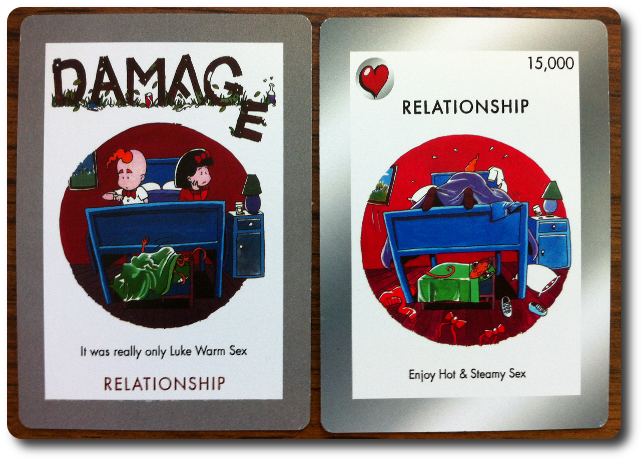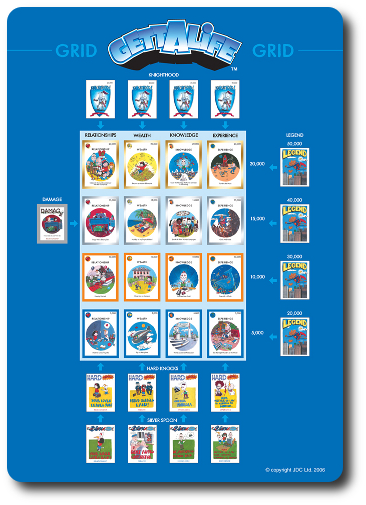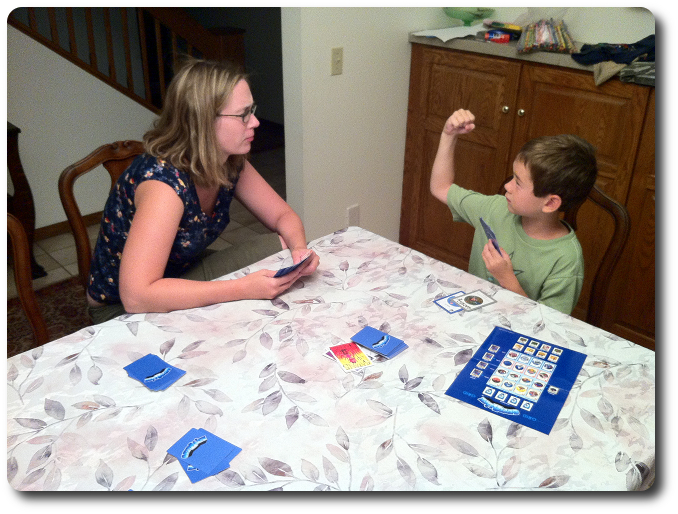
The Basics:
- For ages 8 and up (we disagree, however)
- For 3 to 4 players
- About 30 minutes to complete
Geek Skills:
- Active Listening & Communication
- Counting & Math
- Logical & Critical Decision Making
- Reading
- Pattern/Color Matching
- Strategy & Tactics
- Risk vs. Reward
- Hand/Resource Management
- Trading
Learning Curve:
- Child – Not tested
- Adult – Easy
Theme & Narrative:
- Life is a game (of sorts) and you must do all you can to reach your full potential, but avoid the pitfalls along the way or you’ll never succeed!
Endorsements:
- Gamer Geek approved!
- Parent Geek approved!
- Child Geek not appropriate!
Overview
The choices you make in your life will lead you down the path to new opportunities. This same path could also lead you to a cliff. Thoughtful choices and determination is needed to succeed. An individual who understands that a healthy relationship is just as important (if not more so) than seeking out prosperity will go far. Knowledge and experience are also needed and will serve as invaluable tools. The choices you make will determine what choices are available to you in the future. Here’s hoping you pick the right ones.
Note: This game contains three cards that we found to be inappropriate for our little geeks because of their mature nature. Here is a picture of the cards to help you, the parents, determine if this game is appropriate for your little geeks to play.

Gettalife is comprised of 16 blue bordered Life Goal cards, 12 orange bordered Life Goal cards, 8 silver bordered Life Goal cards, 8 Silver Spoon cards, 4 gold bordered Life Goal cards, 4 Legend cards, 4 Knighthood cards, 4 Knighthood Ninja Stars, 4 Damage cards, 4 Hard Knocks cards, 3 Satans Sinners cards, 3 Divine Intervention cards, 2 Bliss cards, 1 Death Card, 1 foldout Life Grid example sheet, and 1 DVD that contains a visual tutorial on how to play the rules. The artwork is very cartoony and the text is easy to read.
Game Set Up
Note: This game requires each player have at least a 1 foot by 1 foot area in front of them to play their cards. Make sure you set up the game with space for all to play.
To set up the game, find and set aside the Bliss, Divine Intervention, Satans Sinners, and Death cards. These cards will be used during the second round of the game, but not the first. Then collect all the remaining cards to form a single deck and shuffle thoroughly. Deal to each player 5 cards, face-down, and then deal 12 cards, also face-down. These 12 cards are referred to as the “kitty”. They are not in play and should be placed with the other set aside cards for now. The remaining cards are placed in the center of the playing area and form the draw deck. Next to the draw deck should be enough space for a trash (discarded cards) pile.
Set the Knighthood Ninja Stars to one side and within easy reach of at least one player.
It might be helpful to keep the Life Grid example sheet out and visible to all the players for the first game for quick reference.
Players pick up their 5-card hand and look at them, making sure to keep them hidden from their opponents. You are now ready to play the game. The player left of the dealer is the first player.
Life Experiences, Both Good and Bad
The Life Goal cards represent four specific areas. These are Relationships, Wealth, Knowledge, and Experience. The blue bordered Life Goal cards are the most abundant, but as you travel up the Life Grid, building up the levels, the number of Life Goal cards dwindles. This makes the higher tier levels in the Life Grid more difficult to achieve for all the players.
As if this wasn’t challenging enough, the players have cards that can be played on them that will cause problems. Damage cards can be played on a specific silver bordered Life Goal cards that will cause the Life Goal card to no longer provide points. Hard Knocks cards can also be played preventing building in the Life Grid, but these can later be removed with Silver Spoon cards.
The only way a player can protect themselves is by playing Legend cards on their completed rows and having other players play Knighthood cards on their completed columns. These cards, however, cannot be played if a player has a Hard Knocks card in the same row or column. Damage cards can still be played, however.
It’s not all bad news. A player can play cards that are beneficial to their opponents if they like and get points in return. For example, playing a Knighthood on another player will give that player points, but the player who bequeaths the title to another player gets points for doing a good deed as a reward.
Finally, there are Bliss, Divine Intervention, Satans Sinners, and Death cards. These can be nasty, especially the Death card. The Bliss cards allow the player to steal cards from other players, the Divine Intervention cards are like wild cards and can be used to hold spots for Life Goals and swamped out as needed, and the Satans Sinners cards force a player to lose a Life Goal card but they get to pass that card to another player (where they must also use it or be penalized at the end of the game) and force all the players to pass a card.
And then there’s the Death card. This card cannot be played and can only be removed from a player’s hand by passing when a Satans Sinners card is played. The Death card reduces a large number of points for the unfortunate player who is holding it at the end of the game.
A complete description of the cards can be found on the game’s official web site.
The Life Grid
The players will be playing their cards out in front of them during the game in an area referred to as the “Life Grid”. This is a 4×4 card area that represents a life. The player must “build” this Life Grid by first establishing a base with the blue bordered Life Grid cards. After the blue bordered cards are played, then they can build the orange bordered cards, then the silver, and finally the gold bordered cards. While the rows of the grid will represent different “tiers” of success, the columns represent the specific areas of life. From left to right, these are Relationship, Wealth, Knowledge, and Experience.
A player cannot build a new tier unless the tier below has a card in it of the appropriate color and matches the column area of life area or they have built up to that tier in another column. This means the player must always work on a foundation and then build up and over to establish their Life Grid’s rows and columns, or build across the row when they have sufficiently built high enough in one or more columns.

Example of the Life Grid
The only exception to this rule is if an opponent plays a Hard Knocks card on a specific and matching Life Goal card. A Hard Knocks card stops the player from building in that specific column until the Hard Knocks card is removed with a Silver Spoon card.
Building a Life of Your Own
On a player’s turn, they will first pick up a card from the draw deck. At which point, the player has a number of options:
Play Card to Life Grid
The player places one or more Life Goal cards on their Life Grid. If the player has Life Goal cards all of the same border color that are all of the same life area (all wealth, for example), they can play all those cards at once. Players can also play all the cards of a single life area if they would correctly build a column. For example, a player could play a blue, orange, and silver border wealth card all on one turn. Players can also play Legend and Silver Spoon cards on their Life Grid, but not Knighthood cards.
Play Card on Opponent
Damage and Hard Knocks cards can be played on an opponent’s Life Grid to slow them down and to reduce their points. A player can also play a Knighthood card or even a Life Grid card on an opponent’s Life Grid if they think it will benefit them.
Play Other Cards
The Bliss, Divine Intervention, and Satans Sinners cards can be played on the player’s turn instead.
Trade Cards
A player can trade cards with other players, but the player can only trade with a card they just picked up and they already have on their Life Grid. All trades are done at the table and the player can engage any other player in the trade, but they can only trade once. Bliss, Satans Sinners, Divine Intervention, and Death cards cannot be traded.
Trash Cards
A player can decide they don’t want to take any action or play a card and discard a card from their hand. Note that a player can never trash the Death card.
At the end of a player’s turn, if they have less than 5 cards in their hand, they draw back up to 5. It is now the next player’s turn.
Round Two!
After the first deck as been played through, all the cards in the trash (discard) pile, the set aside kitty and the Bliss, Divine Intervention, Satans Sinners, and Death cards are now collected and shuffled together. Deal 5 cards out to all players and place the remaining cards in the center of the playing area. This is the new draw deck. Next to the deck should be enough space for a trash (discarded cards) pile.
Game play continues as normal until the game ends.
Endgame and Scoring
The game ends as soon as the second deck has been played through. All game play immediately stops (although the player who takes the last card can complete their turn) and points are now scored.
Players count the points of the Life Goal cards in their Life Grid and add in the bonus of any Legend cards. Players also add up their Knighthood cards and any Knighthood Ninja Stars they have collected. Any Life Goal cards with a Damage on it is thrown into the trash pile along with the Life Goal card it is attached to. Hard Knocks cards are tossed in the trash, but the Life Goal card remains. All cards in the player’s hand are tossed in the trash except the Death and Satans Sinners cards. These two cards reduce the player’s total score.
Once all the points have been added and any negative points subtracted, the player with the most points wins the game!
Game Variant
Instead of removing the Bliss, Divine Intervention, Satans Sinners, and Death cards, keep them in the deck for the first round of the game. These cards are used and played as they would be as normal. You still need to create a 12 card kitty for the first round. This variant is suggested for player who already know how to play the game.
To learn more about Gettalife and see a video tutorial, see the game’s official web site.
Prediction
This game looks to be fairly straight forward and the rules to build the Life Grid are not terribly complex. I think this game is a bit over my 4-year-old’s head, however, so I will only be testing it with my 7-year-old (soon to be 8). His ability to play games and his age puts him very close, if not fully in, the suggested age range.
It also helps that he is already familiar with games where cards interact. For example, Pokemon and Dungeon Crawler. He’s also familiar with games where you attempt to build something, like Eminent Domain. As a result, explaining the rules to him (and my wife) didn’t take much effort.
After demonstrating the Life Grid, a few of the cards, and discussing some of the tactics and strategies, the players were ready to go. I asked them their thoughts while I set up the game for our first play.
“Looks OK. I like how I can help and hurt other players at the same time.” ~ Liam (age 7)
“Looks kind of cheesy with the art, but I’m willing to give it a shot.” ~ Wife
The cards are dealt and the game is ready! Let’s see if the game delivers or falls woefully short.
Final Word
Whoops….
Let’s take a moment here to reflect on a mistake I made that I hope you, the parents, learn from. By and large, games have themes and images that are more or less appropriate for kids. Even zombie games can be “OK”, as there is not a lot in the way of game actions that would suggest real violence. For example, rolling the dice to hit a number to remove a zombie does not come close to what a movie action equivalent would show for combat. This makes most games available suitable for younger players.
Most, not all. There is the question of artwork, game text, and context.
Some games go just a bit further because their intended audience is more mature. In these games, you’ll see more adult topics such as sex, drugs, alcohol, and more graphic violence. Nothing wrong with these games, mind you, but it is important for parents to know that such games exists. On a purely personal note, which in no way influences this review (must remain objective, after all), I am not pleased with the game publisher’s noted age range for Gettalife. Even though there are only 3 cards in the entire deck that discuss and have images that suggest sex between a couple of people and two monkeys (look at the images above again closely), the suggested age range on the box should be much older than 8+. I don’t know any parents who would be comfortable talking to their children about sex or introducing sexual themes to their children at such a young age. I hope the publishers of this game take this to heart and change the suggested age range or put a note on the box to inform the reader of the mature themes used in the game.
I failed to see the cards with the sexual content when I went through the game for the first time. Silly, really, as it is not only on the card as plain as day, but also on the Life Grid example. As a result, I set up the game and played it with my 7-year-old. You can imagine my disappointment and surprise, as well as my wife’s, when we came across the cards with mature content while playing. Needless to say, we stopped playing the game right then and there with my son. Not one of my better parenting moments. Due to the mature nature of some of the game components, we cannot recommend this game for little geeks.
For the Parent Geeks, this was not a problem. They played the game without issue and quickly caught on to what the game was about and how it was played. Non-gamers were a little slower to pick it up, but not much. The game is very straight forward and there is little in the way to confuse the players. The only big hurdle we really had to jump with the non-gamers were the cards that changed things on a player’s Life Grid or caused cards to be rearranged. Their confusion slowed down the game a bit, but never derailed it.
Gamer Geeks enjoyed the game, surprisingly. They found it to be a light and very casual “screw your opponent” game. Much more thinking needed than other filler card games, but not enough to make it a “full-fledged” game for a game evening. It was fondly described as a “much better and more tolerable version of the Game of Life” and all agreed it was a game they would play again if they were in the right mood.

Very early on in the game – about 2 minutes later, disaster!
Gamer Geeks, this is a light “screw your opponent” and grid building game. The different ways you can score points, influence your own grid, as well as your opponents, make the game much more than just a draw-and-play exercise. But nor will you be burning a lot of your brain cells to figure out what to do on your turn. The limited cards in your hand will keep you focused on hand/resource management, and Life Grids will keep you focused on your opponent. Harming your opponent is sometimes less desirable than helping them, oddly enough. The lack of abundant cards at higher tier levels in the Life Grid will have you racing to build fast and hunting for the missing cards you need for big points.
Parent Geeks, this is a fun game for both the casual and non-gamer, with a bit more time and energy being needed to bring the non-gamer up-to-speed. The game is not complicated, but it can be somewhat overwhelming for players who have not played many card games where cards provide different actions. A player’s turn sequence and building the Life Grid is very straightforward, leaving little to confuse a player other than not necessarily knowing what is the best card to play. Even so, the game plays fast and even big mistakes (in hindsight) are not that horrible as there is usually more than enough game time to recover. For families, though, we cannot recommend this game. If you think your little geeks are old enough and mature enough to handle a cards that suggest sexual activity, have at it.
Child Geeks, sorry, this game is not appropriated for you, in our opinion. There are mature themes in this game that are just a bit too much for you to handle or for adults to want to discuss with you.
Overall, I was left somewhat lukewarm on the game, but still enjoyed it. There is enough to think about on a player’s turn to keep it from being a draw-and-play mindless game with little to no brain power needed. The ability to play cards on your opponent and the points collected (or reduced) from doing so makes it possible to play a number of different ways. You could, for example, enthusiastically help build another player’s Life Grid so you can knight them to collect points. You could also be a real stinker and harm a player’s Life Grid at every turn. Most of the time, you’ll find yourself in the middle, both protecting your own cards, sometimes helping others, and hurting other players when it would appear to be the most beneficial. This level of player interaction keeps the game interesting, competitive, and sometimes downright nasty. Add in the lack of cards for building higher tiers in the Life Grid and a friendly game at the table can get rather heated.
If you are looking for a card game where risky play and thoughtful player decisions are as important as lucky draws from the deck, then do take a look at Gettalife.
This game was given to Father Geek as a review copy. Father Geek was not paid, bribed, wined, dined, or threatened in vain hopes of influencing this review. Such is the statuesque and legendary integrity of Father Geek.



